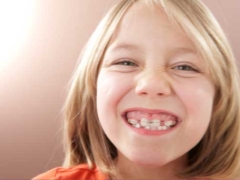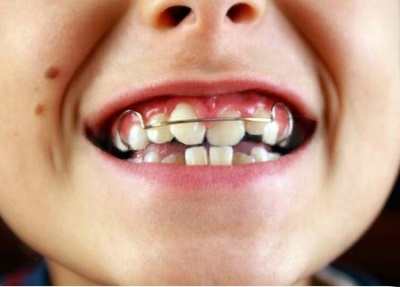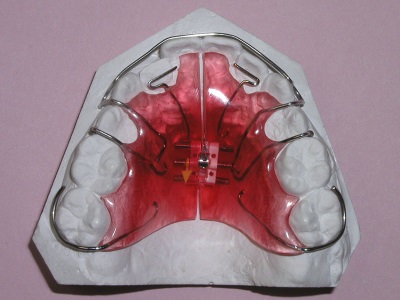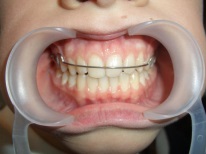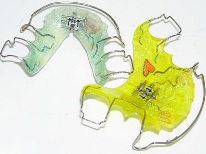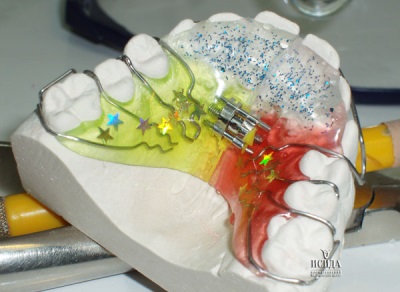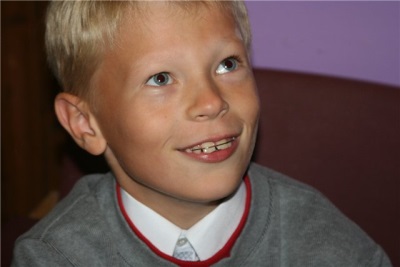Plates for the alignment of teeth in children
If a child’s teeth grow unevenly, these days it will not be an insoluble problem. Techniques have now been developed to adjust the position of the teeth from an early age. One of them is the installation of plates for alignment.
Special features
Alignment plates, also called retainers or staples, are used to correct abnormal bite in a child when it first began to develop. They are recommended for single pathologies, as well as prescribed after the use of braces to consolidate their effect.
Some models of plates differ in their structure, but all such orthodontic appliances have the same basic elements - this is the plate, the wire (arc) and the mount. For the plate itself, use soft or medium hard plastic of different colors. It is bent according to the shape of the baby's sky. The main function of such plastic is to hold the arc made of titanium-nickel alloy.
It is the arc that provides the leveling effect, since it has a “memory” - the initially accepted form of the wire does not change during the load during chewing.
It continuously acts on improperly positioned teeth crowns and causes their gradual displacement. And since the impact force is not too large, the arc does not harm the root system of the teeth. Wire thickness may vary depending on the situation.
Fastening in the plates is represented by a special mechanism at the base, equipped with a small screwdriver. In some plates, the design includes additional elements, for example, built-in activators, which are regularly twisted to keep the arc tightly tight.
Kinds
All plates used in children are divided into:
- Removable. This is the most common version of the plates, attached to the teeth with hooks. They are worn daily, but periodically removed. The main advantages of such structures - ease of use and low price. However, the removable plate can be used only when aligning one tooth, provided that it is slightly shifted. Depending on the characteristics of the structure and purpose, removable plates are single-jaw, with a hand-shaped process, with an active springy pusher, with a retraction arc and others.
- Non-removable. Such plates are usually recommended for the correction of a group of teeth, which requires prolonged exposure. In their design there are locks through which the arc passes. They are needed to periodically tighten the plate so that the crowns remain under the desired pressure. Because of the presence of locks is a non-removable plate is more expensive.
Indications
Plates prescribed for:
- Offset one tooth.
- The wrong arrangement of several teeth.
- Rare arrangement of dental crowns.
- Problems with the development of jaw bones.
- Slowing down or activating jaw growth.
- The sky is narrow.
- The desire to prevent tooth movement after using braces.
Watch the following video about teeth alignment plates.
Contraindications
Leveling plates are not used if the child:
- Periodontitis has developed.
- There are allergies to the components from which the device is made.
- There are respiratory diseases.
- There are teeth affected by caries.
Bite correction
The most common indication for the use of leveling plates is an abnormal milky or interchangeable bite. Such an appointment is justified, because with such a bite, the arrangement of the teeth is fairly easily corrected and does not require a large load.

At the same time, only a dentist should decide whether a plate is needed and also ensure that it is properly installed. Since the root system of temporary teeth is less durable, there is a risk of losing them with excessive pressure on the teeth.
Care
Although elastic plastic and hardened metal are used in the manufacture of leveling plates, improper care of the device can cause it to break. Care for braces should be as follows:
- Every day (at least 1 time) the plate is cleaned with a soft toothbrush and regular toothpaste or a special gel.
- Every week, the staples are treated with a solution that provides deep disinfection. For this, the plate is placed in the solution overnight.
- Before each meal, the plate should be removed.
- Before each installation, the plate is washed with warm boiled water.
- For storage of a design use the special container.
- If the plate is broken, it should immediately be taken to a doctor.
- So that the turning screw does not jam, it is advised to lubricate with a drop of oil.
What to install - plates or braces?
At an early age, orthodontists often recommend the installation of plates, and braces are used to correct teeth in children over 12–14 years of age.
Using braces at an earlier age can affect the development of the bones of the skull.
Prices for records
Installing a leveling plate is much cheaper than using a bracket system - about 2-3 times. To find out the answer to the question “how much does it cost to put the records?”, You need to take into account various factors. The cost of the device is influenced by the design features of the plate, its materials and the level of the clinic in which the brackets will be installed.
On average, a standard disc of standard color from medium hard plastic without additional parts must be paid up to 10 thousand rubles. If the plastic is colored or softer, the cost will increase by 2 thousand or more.
Plates with one screw cost an average of 9 thousand rubles, and each additional screw increases the price by 1-2 thousand rubles. If you need to install a special valve for the language on the device, this will add 500-1500 rubles to the cost of the plate. Devices that help correct the position of chewing teeth, cost an average of 14 thousand rubles.
Installation process
- The manufacture of the plate must be strictly individual. At first, the child examines the orthodontist for detection of problems, and also sends a small patient to an x-ray. Based on the examination, the doctor chooses the type of plate and tells the patient and his parents about the principles of operation of the device.
- After removing a wax cast from a child’s teeth, it is used to create a plaster model on the basis of which the plate is made. The second visit to the doctor involves the installation and adjustment of the structure, which takes about 10 minutes.
- Next, the doctor will inform parents about the features of care, the need to adjust the arc (if applicable), as well as the duration of the use of plates. On average, such a device is worn for about 2 years. If the device is removable, it is advised to wear it for at least 21 hours a day, removing it only for the period of tooth brushing and meals.
As with all orthodontic structures, it takes some time to get used to the leveling plates. In the early days, due to their use, the child may have discomfort and sometimes even painful sensations.Speech may be impaired and saliva secretion may increase. As a rule, all such adaptation symptoms disappear in 3-7 days after installation.
Tips
Since the removable plate is a foreign device, the child will have a desire to remove it, so parents will have to watch this moment. It should be explained to the child that for the effectiveness of the alignment, the plate should be worn for most of the day. If it is constantly removed, the results will appear slower, because of what the device will have to walk longer.
It is also important to pay great attention to the care of the child’s oral cavity. The child must brush his teeth twice a day, removing the plate for this period, and also clean the structure itself.
Reviews
Alignment plates are very popular, but since these devices have both advantages and disadvantages, the feedback about them is very different. Someone is satisfied with the use of plates and the result in the form of even teeth, but someone did not like this straightening of teeth, because it brought more difficulties than expected.
Especially often complain about the distortion of speech and the need to constantly remove the plate for meals, which causes a lot of inconvenience if the child eats not at home.
You can learn more about orthodontic plates by watching the next video.
